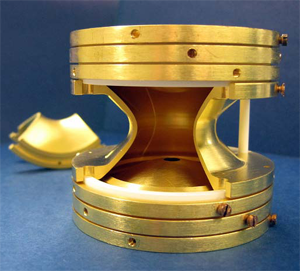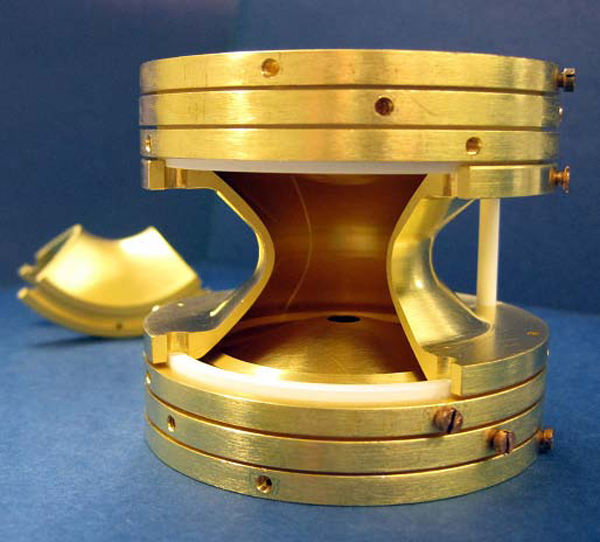Stellar Abundances: Better Measured Than Predicted
If gold had been as abundant on earth as iron, it wouldn’t be as famous for its rarity. If a tiny screw in the cosmic kitchen had been turned by just a bit, iron might have been the one that was most rare and desired, but during the creation of the Universe the course was set differently.
Clarifying what astrophysical conditions could explain the observed elemental abundances depends on precisely knowing the masses of short-lived neutron-rich nuclides. When masses are not yet experimentally available, theoretical nuclear-mass models must be used. In Physical Review Letters, Jonathon Van Schelt at Argonne National Laboratory, Illinois, and colleagues show that only high-precision mass measurements of trapped nuclei, more so than current mass models, permit firm conclusions to be drawn about these astrophysical nuclear reactions [1].
The elements were created by nuclear processes in stars and stellar explosions. Up to iron- —the nucleus with the highest binding energy per nucleon—new elements can be created by fusion reactions in stars. The creation of the heavy elements is still not well understood. The elements between iron and uranium are generally thought to have been produced in supernovae and other stellar explosions. The so-called rapid neutron-capture process ( process) of stellar nucleosynthesis is held responsible for the production of these elements. However, the astrophysical context for a successful process has not yet been identified [2].
The process consists of neutron capture followed, at a rate depending on the half-life of the nucleus, by beta decay, which creates a less neutron-rich isotope closer to the valley of beta stability. In this way, the process follows different paths along the neutron-rich side of the nuclear chart of neutron and proton number. Which exact path is taken depends in part on the astrophysical environment assumed, because different temperature and density conditions reflect in slightly different pathways. Nevertheless, the underlying structure of nuclei also plays a role, making nuclei around the closed shells at neutron number , , and prominent. One of the outstanding questions in nuclear physics is whether these magic numbers retain their cherished characteristics in nuclides far from stability. The most neutron-rich and species are therefore the priority for many experiments in nuclear physics.
Precision mass measurements [3,4] have reached neutron-rich nuclides around and , which are in the region of plausible -process paths. These measurements can, in turn, constrain nuclear-mass models that are needed as input for astrophysical models when experimental masses are not (yet) available. Mass measurements with precision of parts per million are also needed to reliably calculate elemental abundances because, in the balance between neutron capture and the reverse process of photodisintegration, the mass differences between neighboring isotopes determine the -process pathway for a given set of astrophysical conditions. Equally important are the beta-decay half-lives of participating nuclei, which determine the time it takes to build up heavy elements.
Mass measurements provide insight into the nuclear interaction and thus apply to a variety of physics topics. Penning-trap mass spectrometry, in particular, has the advantages of being fast, efficient, and highly accurate [5]. The current experiment was carried out at the Canadian Penning Trap mass spectrometer (CPT) at the Californium Rare Isotope Breeder Upgrade (CARIBU) facility [6].
This facility selects nuclei from spontaneous californium- fission in a large radio-frequency (rf) gas catcher to deliver purified neutron-rich beams to low-energy experiments, such as the CPT (see Fig. 1). The high-intensity gas catcher uses a novel rf focusing structure for rapid and efficient operation at much higher incoming ion current than previously demonstrated, and it routinely provides a low-energy beam with good optical properties all across the nuclear chart in contrast with, for example, the ISOL (Isotope Separation On Line) technique [7].
The mass measurements of neutron-rich tin isotopes and others reported by Van Schelt et al. mark the first mass measurements at the new CARIBU facility using the millicurie fission source. The CPT uses time-of-flight ion-cyclotron resonance in a Penning trap, in conjunction with a reference mass measurement, to extract the mass of the ion of interest. The typical measurement precision was at the level.
Most neutron-capture events in a supernova explosion are thought to occur on time scales of order in environments of temperature kelvin and neutron density . The authors used a code developed by their group to simulate the classical process for a given temperature over a range of neutron densities. For certain environmental conditions, the nuclides they measured lie on the -process path.
Tin isotopes, which have some of the longest beta-decay half-lives, are in a position to limit the progress of material to the heaviest elements. The classical -process waiting time at tin has been calculated directly from accurate, high-precision experimental masses for a feasible set of conditions with minimal model dependence. The calculations show that, when contrasted with the actual measured masses, the widely used mass models render conclusions based on them highly uncertain. The researchers calculate a minimum neutron density to move beyond tin within the typical time scale of or less and thus create significant quantities of heavier elements. More decisive conclusions will not be possible without considerable improvement in either the accuracy of modern nuclear theories or more experimental data on currently unmeasured nuclei.
An alternative theory to the supernova-induced process is the decompression of neutron-star matter by its merger with another neutron star. A landmark paper in 1971 presented a model for neutron stars in which increasingly heavy and neutron-rich nuclides (resulting from electron capture) exist in a state of equilibrium for beta-decay processes [8]. Unlike many scenarios in nucleosynthesis, in which astrophysical uncertainties dominate those resulting from nuclear physics, the elemental abundances of the neutron-star crust model are relatively robust. Recent results from Penning-trap mass spectrometry have also made a contribution to study the elemental composition of the outer crust of neutron stars, where the binding energy is of major input [3,9].
In these experiments, CPT at CARIBU has measured masses for the most neutron-rich nuclides to date and holds the potential to measure nuclei that are even a few neutrons more exotic. The results nicely extend the capabilities of existing radioactive ion-beam facilities until the advent of future projects like FAIR (Facility for Antiproton and Ion Research) in Germany or FRIB (Facility for Rare Isotope Beams) in the US.
References
- J. Van Schelt et al., “First Results from the CARIBU Facility: Mass Measurements on the r-Process Path,” Phys. Rev. Lett. 111, 061102 (2013)
- M. Arnould, S. Goriely, and K. Takahashi, “The -Process of Stellar Nucleosynthesis: Astrophysics and Nuclear Physics Achievements and Mysteries,” Phys. Rep. 450, 97 (2007)
- R. N. Wolf et al., “Plumbing Neutron Stars to New Depths with the Binding Energy of the Exotic Nuclide Zn,” Phys. Rev. Lett. 110, 041101 (2013)
- A. Kankainen, J. Äystö, and A. Jokinen, “High-Accuracy Mass Spectrometry of Fission Products with Penning Traps,” J. Phys. G 39, 093101 (2012)
- K. Blaum, J. Dilling, and W. Nörtershäuser, “Precision Atomic Physics Techniques for Nuclear Physics with Radioactive Beams,” Phys. Scr. T152, 014017 (2013)
- J. Van Schelt et al., “Mass Measurements Near the -Process Path Using the Canadian Penning Trap Mass Spectrometer,” Phys. Rev. C 85, 045805 (2012)
- G. Savard, S. Baker, C. Davids, A. F. Levand, E. F. Moore, R. C. Pardo, R. Vondrasek B. J. Zabransky, and G. Zinkann, “Radioactive Beams from Gas Catchers: The CARIBU Facility,” Nucl. Instr. Meth. B 266, 4086 (2008)
- G. Baym, C. Pethick, and P. Sutherland, “The Ground State of Matter at High Densities: Equation of State and Stellar Models,” Ap. J. 170, 299 (1971)
- S. Kreim, M. Hempel, D. Lunney, J. Schaffner-Bielich, “Nuclear Masses and Neutron Stars,” Int. J. Mass Spectrom. (2013)





